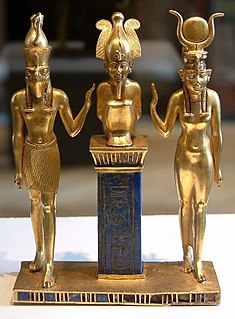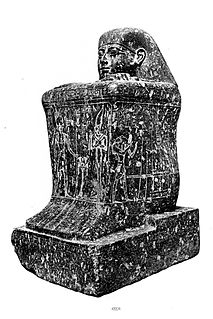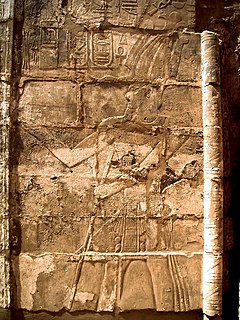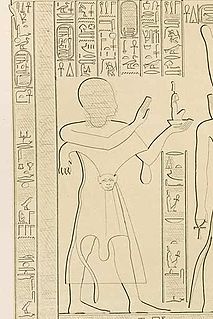
Harsiese B was a High Priest of Amun in 874 BC. Earlier Egyptologists assumed he was both the High Priest of Amun (HPA) and son of the High Priest Shoshenq C, who may have become a king at Thebes. However, recent research by Karl Jansen-Winkeln shows that all the monuments of the first (King) Harsiese A demonstrate that he was never Theban High Priest of Amun in his own right, merely a regular Priest of Amun. [1] While the earlier Harsiese was certainly a king at Thebes, he is clearly a different person from the later Harsiese, Harsiese B, who is attested as a High Priest of Amun. Jansen-Winkeln further shows that Harsiese A's son, [...du], was only an ordinary Priest of Amun.
Amun is a major ancient Egyptian deity who appears as a member of the Hermopolitan Ogdoad. Amun was attested from the Old Kingdom together with his wife Amaunet. With the 11th dynasty, Amun rose to the position of patron deity of Thebes by replacing Montu.

Shoshenq C was the eldest son of the 22nd Dynasty pharaoh Osorkon I and queen Maatkare, the daughter of Psusennes II, and served as the High Priest of Amun at Thebes during his father's reign. Consequently, he was the most important official in Upper Egypt after the king himself. He has generally been equated with Heqakheperre Shoshenq II by the English Egyptologist Kenneth Kitchen and viewed as a short-lived co-regent to his father based on the Nile God British Museum statue 8 which identifies him as the son of Osorkon I and Queen Maatkare, daughter of Hor-Psusennes but this assumption is unproven. In the statue, Shoshenq C is called "the Master of the Two Lands" and the formula "beloved of Amun" is enclosed within a royal cartouche. However, in the text of the statue, he is not given a specific throne name or prenomen, the use of a cartouche by a royal prince is attested in other periods of Egyptian history such as that of Amenmes, son of Thutmose I, and the documents depicts Shoshenq C as a simple High Priest of Amun on the side of the legs of the Nile God, rather than a king.

Thebes, known to the ancient Egyptians as Waset, was an ancient Egyptian city located along the Nile about 800 kilometers (500 mi) south of the Mediterranean. Its ruins lie within the modern Egyptian city of Luxor. Thebes was the main city of the fourth Upper Egyptian nome and was the capital of Egypt mainly during the Middle Kingdom and the New Kingdom. It was close to Nubia and the Eastern Desert, with its valuable mineral resources and trade routes. It was a cult center and the most venerated city of ancient Egypt during its heyday. The site of Thebes includes areas on both the eastern bank of the Nile, where the temples of Karnak and Luxor stand and the city proper was situated; and the western bank, where a necropolis of large private and royal cemeteries and funerary complexes can be found.
Harsiese B is first explicitly attested as High Priest of Amun late under Osorkon II's reign on Statue CGC 42225, which bears this king's cartouche. He likely assumed the office at Thebes when the current High Priest, Takelot F, proclaimed himself as king Takelot II in the final 3 years of Osorkon II's reign. Statue CGC 42225 was dedicated by the "Letter Writer to Pharaoh", Hor IX, who is mentioned on the walls of Temple J at Karnak. Temple J was built in the final years of Osorkon II's reign by the then serving HPA, Takelot F. Hor IX later served under Pedubast I and Usermaatre Meryamun Shoshenq VI, who were direct contemporaries of Shoshenq III of the Twenty-second Dynasty. Shoshenq III once even dispatched his second son, Pashedbast B, to Thebes where the latter "added a vestibule door to Pylon X at Karnak, dating it to the reign of Pedubast." [2] Hor IX served beyond the 25-year reign of Pedubast I and lived into Shoshenq VI's reign under whom his funerary cones were inscribed. [3] Consequently, the High Priest of Amun Harsiese can only be Harsiese B since he was a close contemporary of Hor IX and served late in office under Osorkon II. In contrast, Harsiese A died before the twelfth regnal year of Osorkon II.

Usermaatre Setepenamun Osorkon II was the fifth pharaoh of the Twenty-second Dynasty of Ancient Egypt and the son of Takelot I and Queen Kapes. He ruled Egypt around 872 BC to 837 BC from Tanis, the capital of this Dynasty.

Hedjkheperre Setepenre Takelot II Si-Ese was a pharaoh of the Twenty-third Dynasty of Ancient Egypt in Middle and Upper Egypt. He has been identified as the High Priest of Amun Takelot F, son of the High Priest of Amun Nimlot C at Thebes and, thus, the son of Nimlot C and grandson of king Osorkon II according to the latest academic research. Based on two lunar dates belonging to Takelot II, this Upper Egyptian pharaoh is today believed to have ascended to the throne of a divided Egypt in either 845 BC or 834 BC. Most Egyptologists today, including Aidan Dodson, Gerard Broekman, Jürgen von Beckerath, M.A. Leahy and Karl Jansen-Winkeln, also accept David Aston's hypothesis that Shoshenq III was Osorkon II's actual successor at Tanis, rather than Takelot II. As Aidan Dodson and Dyan Hilton write in their comprehensive book on the royal families of Ancient Egypt:
Takelot II is likely to have been identical with the High Priest Takelot F, who is stated in [the] Karnak inscriptions to have been a son of Nimlot C, and whose likely period of office falls neatly just before Takelot II's appearance.

Pharaoh is the common title of the monarchs of ancient Egypt from the First Dynasty until the annexation of Egypt by the Roman Empire in 30 BCE, although the actual term "Pharaoh" was not used contemporaneously for a ruler until Merneptah, c. 1200 BCE. In the early dynasty, ancient Egyptian kings used to have up to three titles, the Horus, the Sedge and Bee (nswt-bjtj) name, and the Two Ladies (nbtj) name. The Golden Horus and nomen and prenomen titles were later added.
Harsiese B is also attested in office in the sixth regnal year of Shoshenq III in Nile Level Text No.6 and lived into the 18th and 19th regnal years of Pedubast I as Nile Quay Text No.27 shows. During the prolonged civil war which erupted between the forces of Osorkon B and Pedubast I for control of Thebes, Harsiese B sided with Pedubast's faction since the Karnak Quay Texts show he became the latter's High Priest. He died before Year 23 of Pedubast I when this King's new High Priest is revealed to be a Takelot (see Nile Quay Text No.29)
The Nile Level Texts are inscribed on the cult terrace at the temple of Karnak, in Thebes, Egypt. This cult terrace itself was constructed during the time of Ramesses II, but the kings of the 22nd to the 26th Dynasties recorded the height of the Nile on its western side. The inscriptions are invaluable records since they are dated to specific years of a certain king's reign.
Harsiese B consequently served in office for almost 3 decades under Osorkon II (final three years), Shoshenq III (first 7-8 years) and Pedubast I (at least 18-19 years), and must have been Crown Prince Osorkon B's chief rival for this office at Thebes since he was affiliated with Osorkon's rival. Harsiese B must have been a fairly young man perhaps in his early thirties when he first assumed the Office of High Priest judging by his long career.












